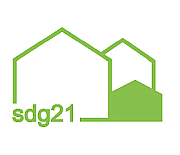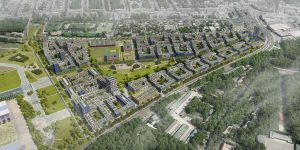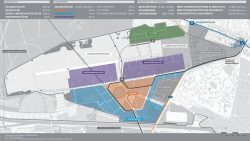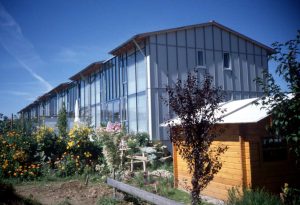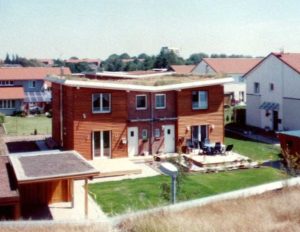![]() D - 13405 Berlin-Tegel: A climate-neutral urban quarter in timber construction with more than 5,000 apartments is to be built. This will make it the largest timber construction quarter in the world. In addition to the apartments, several schools, daycare centers, sports facilities, shopping opportunities and lots of greenery are also planned for the development area with 48 ha is planned. Strong greening ensures climate-adapted and water-sensitive urban development and also has an impact beyond the neighbourhood. Start of building construction: 2022 Planned completion: 2030
D - 13405 Berlin-Tegel: A climate-neutral urban quarter in timber construction with more than 5,000 apartments is to be built. This will make it the largest timber construction quarter in the world. In addition to the apartments, several schools, daycare centers, sports facilities, shopping opportunities and lots of greenery are also planned for the development area with 48 ha is planned. Strong greening ensures climate-adapted and water-sensitive urban development and also has an impact beyond the neighbourhood. Start of building construction: 2022 Planned completion: 2030
Address: Kurt-Schumacher-Platz
Urban mix of uses
The plan is to create an innovative and lively urban quarter characterised by high urban planning quality, an exciting functional and social mix, architectural diversity and a wide range of housing options for all population groups.
new forms of manufactures and non-disruptive industries
In addition, the residential quarter is to become an "urban lab", i.e. a place where technologies for the city of the future find their way into our everyday lives. This includes ideas, concepts and technologies that ensure the responsible use of raw materials, energy and waste.
Use of innovative processes and solutions for the cost-effective, attractive and climate-neutral construction of residential buildings
Securing of lively ground floors in sub-areas for the urbanisation of the district and for the formation of neighbourhoods
CO2-neutral neighbourhood development
Measures for CO2-neutral neighbourhood development (energy supply - buildings - mobility), e.g.:
- Implementation of the open low-temperature heat network (LowEx) with decentralised feed-in of renewable heat from the buildings and development of technical building equipment optimised for this purpose
- Comprehensive generation and storage of renewable energy for on-site power supply, taking into account and integrating the needs of electromobility
- Creation of comprehensive offers for the promotion of electromobility
- Use of renewable raw materials in building construction (e.g. timber construction, insulation), avoidance of petrochemical products as far as possible and consideration of the reusability of building materials and products.
Mobility
"Active mobility" - i.e. cycling and walking - has priority! This is to be ensured by 6-metre-wide cycle paths. This will make the use of one's own car superfluous for many. Car-sharing services will be available at so-called "mobility hubs" in the district. In addition to electric cars, new forms of mobility such as self-driving cars will also be used.
Sponge City
Application of the principle of the sponge city with specific requirements for rainwater management and open space and roof design (as much water retention as possible with the aim of increasing evaporation).
- Establishment of water-retaining structures (e.g. cascade systems) in private and public spaces (roofs, facades, courtyards, development areas, parks), taking into account local soil conditions.
- Integrative open space design and multiple use of open spaces, e.g. for rainwater management, as play areas and for biotope development
- Reduction of heat development through targeted measures to improve the microclimate (including coupling decentralised rainwater management with vegetation, colour and materiality of surfaces and greening of facades)
DGNB certification
To ensure sustainable development of the quarter, certification by the German Sustainable Building Council (DGNB) is being sought for the urban quarter. (DGNB) is being sought for the quarter.
Stakeholders
Low-threshold access to real estate for public welfare-oriented user groups and sponsors as well as cooperatives in a transparent conceptual procedure
Urban planning competition 2016
1st prize: scheuvens + wachten plus planungsgesellschaft mbH, Dortmund
Author: Stefan Hartlock
Staff: Jonas Kleinemeier
WGF Landscape, Nuremberg
Author: Prof. Gerd Aufmkolk
Video (2020) Senate Building Director Regula Lüscher on the Schumacher Quarter
Show the whole blog post >>
Links
www.schumacher-quartier.de
www.stadtentwicklung.berlin.de/...schumacher-quartier
Entwicklungsgesellschaft Tegel Projekt GmbH (state-owned company)
www.tegelprojekt.de
Urban planning competition
www.stadtentwicklung.berlin.de/...staedtebaulicher-wettbewerb.shtml
YouTube-Channel of Berlin TXL with more than 60 contributions:
www.youtube.com/channel/UCDaBx4WIHIXaSflCPfbYpJA/videos
The project in the HolzWohnBau study: https://hwb24.eu/projekt/schumacher-quartier/
Press articles
Detailed taz article from 7. 11. 2020
https://taz.de/Tegel-wird-zur-Urban-Tech-Republic/!5723474/
Interview with the Green building politician Andreas Otto about the Schumannquartier from 4.2.2020
https://taz.de/Interview-mit-Andreas-Otto-Gruene/!5661851/
www.bz-berlin.de/...darum-baut-berlin-in-tegel-auf-holzbau-wohnungen
www.bz-berlin.de/...berlin-baut-in-tegel-auf-holzbau-wohnungen
Last updated: 6 January 2024
Similar projects on sdg21:
All project/s of the planning office: ; City region: Berlin and surrounding area; Country: Germany; Characteristics: 03 - 4 floors, 05 - 6 floors, 07-10-storey, Cooperative, Multi-storey housing, Rental apartments, Residential, Eco-city; typology: Quartier; Thematic: CarSharing, Green roofs, E-cars, Electromobility, Wood construction, Wood hybrid construction, Rainwater infiltration, Resource-efficient construction, Urban timber construction, Water, Water design
